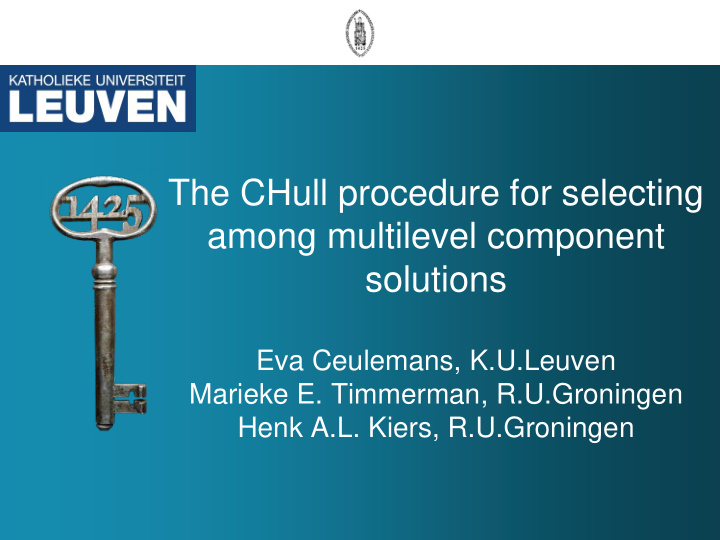



The CHull procedure for selecting among multilevel component solutions Eva Ceulemans, K.U.Leuven Marieke E. Timmerman, R.U.Groningen Henk A.L. Kiers, R.U.Groningen
1. Class of multilevel component models • two-level multivariate data 23 descriptors 30 cheeses 30 cheeses 30 cheeses 30 cheeses – example: sensory profiling study panelist 1 • 8 panelists were asked to rate samples of 30 cream cheeses on 23 descriptors panelist 2 panelist 3 panelist 4
1. Class of multilevel component models • similar to ANOVA, data are split up in two parts: DATA ( X ) = BETWEEN PART ( X b ) + WITHIN PART ( X w ) mean values of each panelist differences between-panelists deviations from mean values per panelist differences within-panelists
1. Class of multilevel component models = + X X X b w i i i = + + f B F B E b b w w 1 ' ' K i i i i i b f 1 1 w ’ B 1 w X 1 F 1 E 1 1 … b 1 f 2 w ’ B 2 1 w X 2 F 2 E 2 … = … + … + B b ’ … … … … b f I 1 w ’ B I 1 w X I F I E I 1 …
1. Class of multilevel component models = + + X f B F B E b b w w 1 ' ' i K i i i i i variant Within-Loadings Correlations Variances B w F F w w i i i MLCA Free - - MLSCA-P Equal for all i Free Free MLSCA-PF2 Equal for all i Equal for all i Free MLSCA-IND Equal for all i Equal to 0 Free MLSCA-ECP Equal for all i Equal for all i Equal for all i
1. Class of multilevel component models b f 1 1 w X 1 F 1 E 1 1 … b 1 f 2 1 w X 2 F 2 E 2 … = … + + B b ’ B w ’ … … … … b f I 1 1 w X I F I E I 1 …
2. CHull heuristic • between-model selection problem – number of between-components? • within-model selection problem – variant? number of within-components? • formal rule which assesses complexity of different solutions by considering number of free parameters (Ceulemans & Kiers, 2006)
2. CHull heuristic: within-part ≈ X F B w w w ' i i i # component scores + # loadings – Q w ² - Q w transformation freedom mean within-component score of each panelist = 0
2. CHull heuristic: within-part ≈ X F B w w w ' i i i # component scores + # loadings – Q w ² - Q w • #cheeses* Q w : if #cheeses increases, term becomes too large • min(#cheeses,ln(#cheeses)*#variables)* Q w : mitigates influence of additional cheeses -> works well in simulation study!
2. CHull heuristic: within-part 90 solutions on higher boundary of convex hull → solutions with best balance of 80 complexity and fit to data 70 60 VAF 50 MLCA MLSCA-ECP 40 MLSCA-IND MLSCA-PF2 30 MLSCA-P hull 20 0 500 1000 1500 2000 2500 300 number of parameters
2. CHull heuristic: within-part 90 solutions on higher boundary of convex hull → solutions with best balance of 80 complexity and fit to data 70 60 VAF select solution that maximizes 50 MLCA − − vaf vaf vaf vaf MLSCA-ECP 40 − + i i 1 i 1 i MLSCA-IND − − c c c c − + MLSCA-PF2 i i i i 1 1 30 MLSCA-P hull 20 0 500 1000 1500 2000 2500 300 number of parameters
3. Simulation study: 84240 data sets • assessing the number of between-components: easy (98.8%) • determining the number of within-components: easy (91.4%) • tracing the underlying within-model variant (60.71%): – differences in within-loadings: easy – differences in variances of within-components: easy – differences in correlational structure of within- components: difficult (procedure often indicates that correlations differ, whereas they do not)
4. Discussion • CHull heuristic is a useful tool • more fundamental problem remains: how to determine number of free parameters in component analysis?
References • Ceulemans, E., & Kiers, H.A.L. (2006). Selecting among three-mode principal component models of different types and complexities: A numerical convex hull based method. British Journal of Mathematical and Statistical Psychology , 59 , 133-150. • Ceulemans, E., Timmerman, M.E., & Kiers, H.A.L. (in press). The CHULL procedure for selecting among multilevel component solutions. Chemometrics and Intelligent Laboratory Systems. • Timmerman, M.E. (2006). Multilevel component analysis. British Journal of Mathematical and Statistical Psychology, 59, 301–320.
Recommend
More recommend